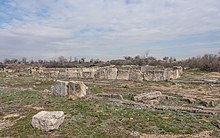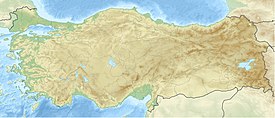Colossae
This article has multiple issues. Please help improve it or discuss these issues on the talk page. (Learn how and when to remove these template messages)
|
Κολοσσαί (Kolossoí) | |
 Ruins of Colossae | |
| Region | Phrygia |
|---|---|
| Coordinates | 37°47′12″N 29°15′36″E / 37.78667°N 29.26000°E |
| Part of | West Asia |


Colossae (
Location and geography
Colossae was located in
Origin and etymology of place name
The medieval poet Manuel Philes, incorrectly, imagined that the name "Colossae" was connected to the Colossus of Rhodes.[9] More recently, in an interpretation which ties Colossae to an Indo-European root that happens to be shared with the word kolossos, Jean-Pierre Vernant has connected the name to the idea of setting up a sacred space or shrine.[10] Another proposal relates the name to the Greek kolazo, "to punish".[9] Others believe the name derives from the manufacture of its famous dyed wool, or colossinus.[11]
History
Before the Pauline period
This section needs expansion with: a cohesive account of the history of the municipality and its peoples and cultures, as appear in many texts on the subject. You can help by adding to it. (February 2016) |
The first mention of the city may be in a 17th-century BC Hittite inscription, which speaks of a city called Huwalušija, which some archeologists believe is a reference to early Colossae. The 5th-century geographer Herodotus first mentions Colossae by name and as a "great city in Phrygia", which accommodates the Persian king Xerxes I while en route to wage war against the Greeks in the Greco-Persian Wars– showing the city had already reached a certain level of wealth and size by this time.[12] Writing in the 5th century BC, Xenophon refers to Colossae as "a populous city, wealthy and of considerable magnitude".[13] It was famous for its wool trade. Strabo notes that the city drew great revenue from the flocks, and that the wool of Colossae gave its name to colour colossinus.[14]
In 396 BC, Colossae was the site of the execution of the rebellious Persian satrap Tissaphernes, who was lured there and slain by an agent of the party of Cyrus the Younger.[15]
Pauline period
Although during the

The canonical biblical text Epistle to the Colossians is addressed to the Christian community in Colossae. The epistle has traditionally been attributed to Paul the Apostle due to its autobiographical salutation and style,[21][22] but some modern critical scholars now believe it to be written by another author some time after Paul's death.[23] It is believed that one aim of the letter was to address the challenges that the Colossian community faced in its context of the syncretistic Gnostic religions that were developing in Asia Minor.[17]
According to the Epistle to the Colossians,
The city was decimated by an earthquake in the 60s AD, and was rebuilt independent of the support of Rome.[28]
The Apostolic Constitutions list Philemon as a bishop of Colossae.[29] On the other hand, the Catholic Encyclopedia considers Philemon doubtful.[30]
The first historically documented bishop is Epiphanius,[
Byzantine period and decline
This section needs expansion with: with SOURCED material relevant to its destruction by the Saracens and the Turks. You can help by adding to it. (February 2016) |
The city's fame and renowned status continued into the Byzantine period, and in 858, it was distinguished as a Metropolitan See. The Byzantines also built the church of St. Michael in the vicinity of Colossae, one of the largest church buildings in the Middle East. Nevertheless, sources suggest that the town may have decreased in size or may even been completely abandoned due to Arab invasions in the seventh and eighth centuries, forcing the population to flee to resettle in the nearby city of Chonai (modern day Honaz).[11]
Colossae's famous church was destroyed in 1192/3 during the Byzantine civil wars. It was a suffragan diocese of Laodicea in Phyrigia Pacatiana but was replaced in the Byzantine period by the Chonae settlement on higher ground[4]
Modern study and archeology
This section needs expansion with: with SOURCED material relevant to the history of its mapping and historical and literary discussion (see further reading), and on plans for its excavation. You can help by adding to it. (February 2016) |
As of 2019, Colossae has never been excavated, as most archeological attention has been focused on nearby Laodicea and Hierapolis,
Modern legacy
The holiness and healing properties associated with the waters of Colossae during the Byzantine era continue to this day, particularly at a pool fed by the Lycus River at the Göz picnic grounds west of Colossae at the foot of Mt. Cadmus. Locals consider the water to be therapeutic.[33]
See also
Notes and references
- S2CID 129096978.
- ISBN 9780802828057.
- ^ Trainor, Michael, Colossae - Colossal In Name Only? Biblical Archaeology Review, March/April 2019, Vol. 45, No. 2, p. 45.
- ^ )
- ^ The History of Herodotus — Volume 2 by Herodotus.
- ISBN 978-3647533971. Retrieved 17 February 2016. The case is made exhaustively in this book, over pages 11-37, wherein it states—after dispensing with a further false association of the ancient city with the island of Rhodes the home of The Colossus of Rhodes, which resulted in its being misplaced for hundreds of years (by "almost 200 kilometers to the south-west," p. 18ff)—in summary, that: "Colossae's various positions on early maps confirmed the confusion over identity [opening section title]. Cartographers positioned Colossae to the west (rather than south-east) of Laodicea7 or, as 'Conos', between Laodicea to the north-west and Hieropolis to the north-east.8 [p. 11] … 'Chonos' or some other guesttimation of the spelling of Honaz12 sometimes subsumed Colossae. [p. 13] … The inhabitants of the immediate vicinity of the ancient site [Colossae, which had ceased to exist] were shackled in bureaucratic tabulation for tax purposes to the town of Honaz. [p. 14] … When Frances Arundell's sketch of Honaz appeared in 1834, the town had descended from the mountain heights [it was a mountain fortress, Honazdağ] but it was similarly labelled, albeit after the fashion of Nicetas Choniates: 'Chonas, … anciently Colossae'.98 [p. 32] … The question was whether Honaz and Colossae were to be equated or separated and whether the contemporary Honaz was the means to pinpoint the ancient… site. [p. 33] … William Hamilton became the one credited with the separation of Colossae from Chonai with the former's location at the mound three kilometers to the north of Honaz.108 [p. 35] … Two photographs of the 'Ruines de Colossae' and 'Chonas' by Henri Carmignac published toward the endif the nineteenth century finally eliminated the concordant visualisation of the places that had been the legacy of Arundell (Fig. 11).113 [p. 37]." For much earlier sources presenting the errant historical opinion, see the next two citations.
- ^ Smith, William (1854). "Colossae". Dictionary of Greek and Roman Geography. London: Walton & Maberly.
- ^ Pétridès, Sophrone (1908). "Colossae". Catholic Encyclopedia. Vol. 4. New York, NY: Robert Appleton Company.
- ^ a b Cadwallader, Alan H., and Michael Trainor (2011). "Colossae in Space and Time: Overcoming Dislocation, Dismemberment and Anachronicity". In Cadwallader and Trainor, eds. Colossae in Space and Time: Linding to an Ancient City. Vandenhoeck & Ruprecht. pp. 18–19.
- ^ Vernant, Jean-Pierre (2006) [1965]. Myth and Thought Among the Greeks. Third edition of a translation from the French originally published in 1983, from a French work published in 1965. Zone Books. p. 321.
- ^ a b Trainor, Michael, Colossae - Colossal In Name Only? Biblical Archaeology Review, March/April 2019, Vol. 45, No. 2, p. 47.
- ^ Trainor, Michael, Colossae - Colossal In Name Only? Biblical Archaeology Review, March/April 2019, Vol. 45, No. 2, p. 46.
- ^ Watson, J. S. (2007). The First Four Books of Xenophon's Anabasis. Project Gutenberg. p. 6.
- ^ The Geography of Strabo, Volume 2 (of 3) by Strabo. p. 334.
- ^ . Encyclopædia Britannica. Vol. 26 (11th ed.). 1911.
- ISBN 9783647533971.
- ^ ISBN 0385025335. Retrieved 17 February 2016.
[Quoting:] Those churches which claimed an apostolic foundation attached great importance to the maintenance of the teaching which they had originally received. There were powerful forces at work in many of them which militated against the maintenance of that teaching; chief among these were those tendencies which in a few decades blossomed forth in the elaborate systems of the various schools of Gnosticism. One form of incipient Gnosticism is the syncretistic angel-cult of nonconformist Jewish foundation and pagan superstructure attacked in the Epistle to the Colossians.
- ^ Cadwallader, Alana; D. Kim; S. Hathaway (2012). "St Michael of Chonai and the Tenacity of Paganism". Intercultural Transmission throughout the Medieval Mediterranean: 100-1600 CE. London, New York: Continuum. p. 64. Retrieved 2 June 2021.
- OCLC 8864974334. Archivedfrom the original on 2 June 2021.
- ^ "Angels of a Christian God: Christian angelos veneration in late Roman Anatolia" (pdf). p. 137.
- ISBN 978-0-8010-2667-6.
- ^ "Colossians 1:1 Paul, an apostle of Christ Jesus by the will of God, and Timothy our brother, 2 To God's holy people in Colossae, the faithful brothers and sisters in Christ".
- ^ Cross, F.L., ed. (2005), "Colossians, Epistle to the", The Oxford Dictionary of the Christian Church, New York: Oxford University Press.
- ^ (Col. 1:7; 4:12)
- ^ Pétridès, Sophrone (1908). "Colossae". Catholic Encyclopedia. New York, NY.
Colossæ was the home of...Onesimus and Epaphras, who probably founded the Church of Colossæ.
{{cite book}}: CS1 maint: location missing publisher (link) - ^ Col. 1:4
- Philemon 1:22
- ^ "Background on Colossae and the Colossians | Bible Commentary | Theology of Work". www.theologyofwork.org. Retrieved 7 April 2020.
- ^ Translated by James Donaldson. (1886). "(Book VII) Section 4". Apostolic Constitutions. From Ante-Nicene Fathers, Vol. 7. Edited by Alexander Roberts, James Donaldson, and A. Cleveland Coxe. Buffalo, NY: Christian Literature Publishing Co. Retrieved 28 December 2018.
Of Colossæ, Philemon.
- ^ Pétridès, Sophrone (1908). "Colossae". Catholic Encyclopedia. New York, NY. Retrieved 28 December 2018.
Besides St. Epaphras... Archippus and Philemon, especially the latter, are very doubtful.
{{cite book}}: CS1 maint: location missing publisher (link) - ^ a b Trainor, Michael, Colossae - Colossal In Name Only? Biblical Archaeology Review, March/April 2019, Vol. 45, No. 2, p. 48.
- ^ Trainor, Michael, Colossae - Colossal In Name Only? Biblical Archaeology Review, March/April 2019, Vol. 45, No. 2, p. 49.
- ^ Trainor, Michael, Colossae - Colossal In Name Only? Biblical Archaeology Review, March/April 2019, Vol. 45, No. 2, p. 50.
![]() This article incorporates text from a publication now in the public domain: Easton, Matthew George (1897). "Colossae". Easton's Bible Dictionary (New and revised ed.). T. Nelson and Sons.
This article incorporates text from a publication now in the public domain: Easton, Matthew George (1897). "Colossae". Easton's Bible Dictionary (New and revised ed.). T. Nelson and Sons.
Further reading
- Bruce, F.F. [Frederick Fyvie] (1980) [1969]. New Testament History. New York, NY: Galilee/Doubleday. pp. 415f. ISBN 0-38502533-5. Retrieved 17 February 2016.
 This article incorporates text from a publication now in the public domain: Easton, Matthew George (1897). "Colossae". Easton's Bible Dictionary (New and revised ed.). T. Nelson and Sons.[needs update]
This article incorporates text from a publication now in the public domain: Easton, Matthew George (1897). "Colossae". Easton's Bible Dictionary (New and revised ed.). T. Nelson and Sons.[needs update]- Bennett, Andrew Lloyd. "Archaeology From Art: Investigating Colossae and the Miracle of the Archangel Michael at Kona." Near East Archaeological Society Bulletin 50 (2005):15–26.
External links
- Map and pictures of ruins
- . Encyclopædia Britannica. Vol. 6 (11th ed.). 1911. pp. 725–726.


